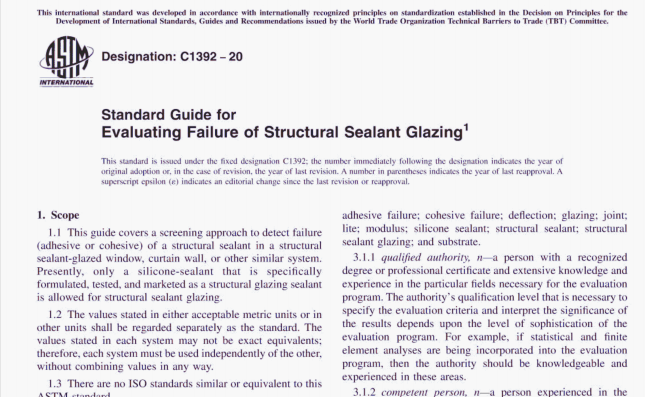ASTM C1392:20 pdf download.Standard Guide for Evaluating Failure of Structural Sealant Glazing.
7. Sampling
7.1 The qualified authority should specify the locations. distribution, and number of applied loads for the structural sealant glazing system. Sections 8 and 9 discuss various approaches to this selection process.
8. Establishing Deflection and Sealant Failure Relationship
8. I Summary of Procedure—Establishing the deflection! failure relationship requires the specifying authority to select the applied load magnitude. the locations of the applied loads on the lite, and the criteria for failure length. The following describes various approaches that can be used to select these parameters. depending upon the sophistication of the evaluation program and the desired results. Depending upon the parameters selected the procedure can be used as a crude screening tool or can be correlated to the actual stresses within the structural sealant joint under an applied load and used as a rational means of assessing areas of failure that require repair. Using the deflection magnitudes and locations, the initial evaluation establishes the relationship between loaded lite deflections with intact structural sealant and those with failed structural sealant.
8.2 Applied Load Magnitude The qualified authority specifies the magnitude of the applied load. The load should be large enough to produce significant differences in deflection between intact and failed sealant areas, that is, the failure length criteria. The applied load can be derived from the glazing system’s lateral design loads through computer modeling (finite element analysis), if it is necessary to relate the testing to a design load and stress.
8.2.1 An initial evaluation will determine whether the applied load is large enough to produce significant diflèrences in deflection between areas with intact structural sealant and those with failed structural sealant. Excessive loads may crack, kink or otherwise damage the glazing material.
8.3 Applied Load Locations on a LAte—The evaluation procedure involves application of a local load to a discrete portion of the edge of a lite. Therefore, a single application does not necessarily evaluate a structural sealant joint along the entire edge of a lite. The stress distribution in the structural sealant from the applied load is a function of many variables. including the relative slitiness of the sealant and glazing material, the location of the suction cup, and any resistance from setting blocks or similar items. The qualified authority should specify the extent of testing that is appropriate along each edge of a lite. This determination can be influenced by the degree of assurance that is required from the evaluation program. One approach is to space a number of load application points periodically along the edge of a lite. At close spacings, this approach can evaluate virtually the entire length of the structural sealant joint. However, the duration and cost of such a program can be substantial. Another approach is to make a preliminary study of lites with failure to assist in understanding the failure mechanisms that have occurred and then use this information to select applied load locations in the areas most likely to have failed.
ASTM C1392:20 pdf download
